
CABR Making Measured Progress
Written by William C. Vantuono, Editor-in-Chief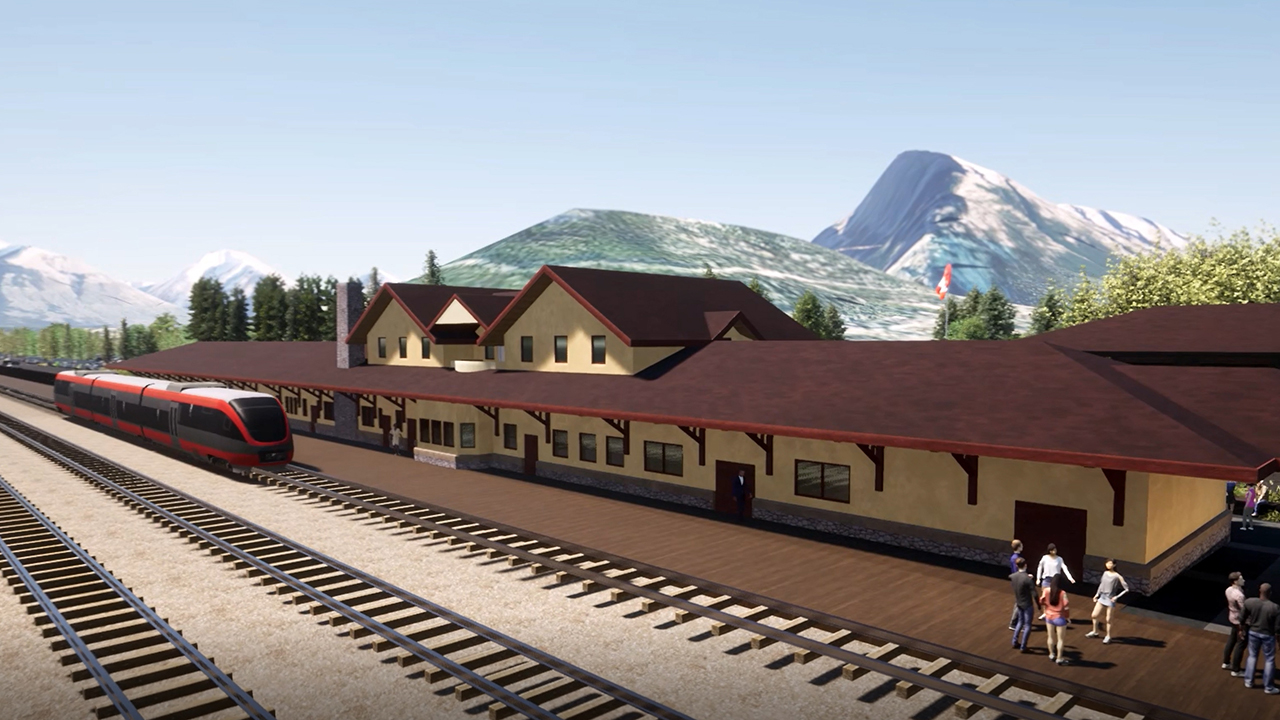
Liricon Capital Ltd. and Plenary Americas, a portfolio company of Caisse de dépôt et placement du Québec (CDPQ), have advanced Phase 4, design, of the Calgary Airport – Banff Rail (CABR) project, which is planned to be built within the Canadian Pacific right-of-way but not share operations. CP, which has signed a non-binding MOU (memorandum of understanding) with Liricon/Plenary, told Railway Age that it is supporting the project and is prepared to offer design and engineering assistance, with the requirement that the passenger service have no impact on CP’s main line freight operations.
Liricon/Plenary submitted an Enhanced Unsolicited Proposal in November 2021 to the Government of Alberta Ministry of Transportation, Invest Alberta Corp. and Canada Infrastructure Bank (CIB) to advance the CABR project from Phase 3, development, to Phase 4. The consortium said in early July that it had reached 11 milestones:
- Obtaining an improved economic impact analysis.
- Developing a solution for region-wide transportation through a Calgary Airport rail hub.
- Initiating an operations integration strategy with the potential Edmonton-Calgary high speed rail project.
- Furthering a wildlife impact mitigations approach.
- Investigating hydrogen fuel-powered rolling stock and supply alternatives.
- Securing support from affected municipalities/governments.
- Solidifying tourism industry support.
- Receiving business stakeholder support.
- Initiating engagement with Stoney Nakoda First Nations people.
- Advancing construction strategy.
- Improving ridership forecasts.
“These achievements will decrease the time to complete Phase 4, reduce development risk and enhance the proposal’s attractiveness,” Liricon/Plenary said. “This progress supports CABR’s ability to improve the environment, including being North America’s first hydrogen-powered passenger train system; expand the tourism economy by providing passengers seamless travel experiences with airlines, hotel companies and hospitality operations; increase labor mobility through integration with local transit systems, and being the foundation upon which to advance complementary new rail systems including Edmonton-Calgary HSR (Prairie Link Partnership consisting of EllisDon & AECOM); and reduce the impact of vehicles in Banff National Park and support the BANFF NATIONAL PARK NET ZERO 2035 initiative. New analysis indicates that, should Parks Canada adopt policies that encourage Banff National Park visitors to use mass transit options like CABR rather than personal vehicles, there would be an opportunity to reduce or eliminate the proposed Provincial financial contribution.”
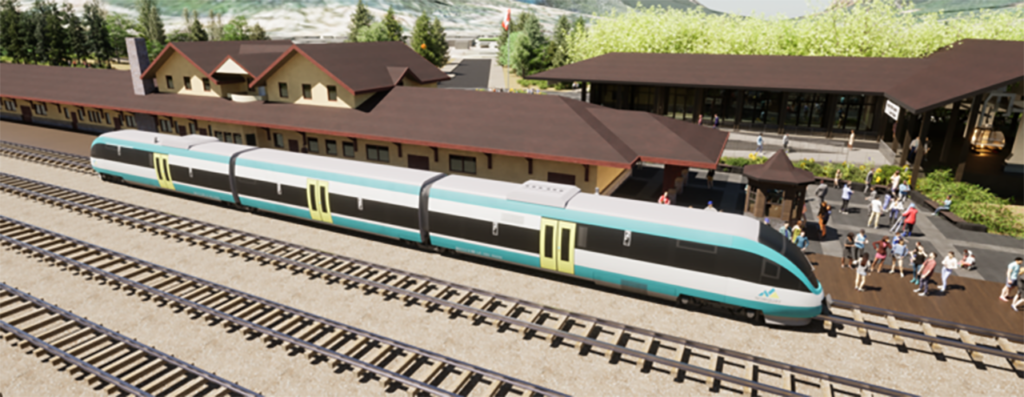
CABR now needs the Government of Alberta to match funding of up to C$10 million that is being contributed by Liricon/Plenary and CIB, to complete the second stage of Phase 4 and achieve a final investment decision. Liricon/Plenary will then fund the third and fourth stages of Phase 4, permitting and financial close, budgeted at C$75 million.
“The Government of Alberta can then decide whether to continue to the next stage, based on the more detailed information then available to it, and will ultimately make a final investment decision whether to proceed into permitting and the project’s fifth and final phase, construction and Implementation,” the consortium noted. “This process provides the Government of Alberta with multiple opportunities to decide whether to continue to advance the project, and thereby limits the Government of Alberta’s development risk. The project is uniquely low-risk to Alberta taxpayers since the structure proposed for CABR is a P3 (public-private partnership) designed to share commercial risks across multiple partners, including risks relating to capital costs, ridership and revenue.”
Liricon/Plenary said CABR’s P3 structure “is different from the conventional government approach of using solely taxpayer money to develop, procure and build public transit projects. In 2016, CIB was established to structure and fund P3 projects that take the commercial risk government usually is forced to assume under traditional delivery models. The Government of Alberta had the vision to create an Unsolicited Proposal framework to accommodate this new, innovative P3 structure.”
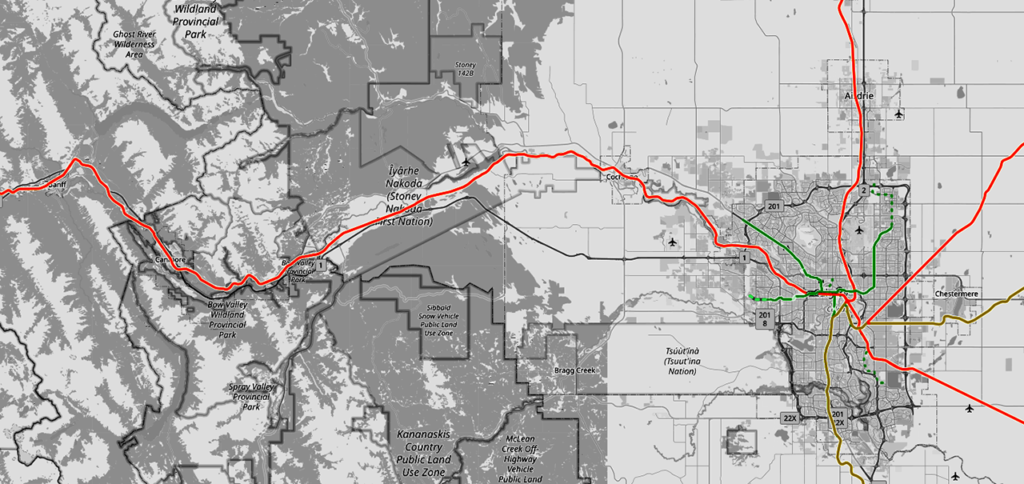
The CABR system will operate on a new, dedicated passenger line built within the existing CP freight corridor and “will provide high frequency, reliable service” among seven destinations: Calgary Airport, Calgary Downtown, Calgary Keith, Cochrane, Morley (Stoney Nakoda First Nations), Canmore and Banff. Three service classes are envisioned. Economy class tickets are estimated to be about C$10 from the Airport to Downtown Calgary and C$20 from Downtown Calgary to Banff, taking into account discounts for entry to Banff National Park. The projected start-up date is rather ambitious: 2026.
As planned by Liricon/Plenary, CIB will provide 50% of the project’s C$1.5 billion capital cost, with the remainder sourced from a combination of debt from private lenders and Liricon/Plenary. A portion of the capital costs and interest would be paid back, once service is operational, by Alberta Province—C$30 million annually for 50 years, after which Alberta would assume full ownership. A yet-to-be -named private company would build and operate the system. Liricon Chairman Adam Waterous told Railway Age that the province’s $30 million in annual payments “may not be needed if Banff National Park supports transit use by raising its entry fee for private passenger cars, or expanding bus and shuttle service between park attractions.”
Liricon/Plenary engaged Mott MacDonald to undertake an economic impact assessment of CABR. “For perspective, according to a Tourism Economic Impact Study by Grant Thornton in 2016, the overall province-wide gross output economic impact from Banff and Canmore was approximately C$3.145 billion in 2015,” Liricon/Plenary noted. “Banff and Canmore generate C$8.6 million in economic activity each day for Alberta. Provincial and federal taxes generated from Banff and Canmore were roughly C$199 million and C$377 million respectively in 2015. CABR will support and grow these figures.
“The Mott MacDonald report indicates that the project will deliver an economic rate of return on the proposed investment by the Government of Alberta of more than 6.9 times. The study conservatively forecasts the project’s cost benefit ratio to be 2.8 times, and the project is expected to contribute more than 9,880 job-years of employment during construction and an additional 22,500 jobs and C$6.4 billion of gross value added to the Alberta economy once completed. These conservatively estimated economic benefits almost triple when using Liricon/Plenary’s upside ridership projections underpinning the broad and diverse benefits to the Province.”
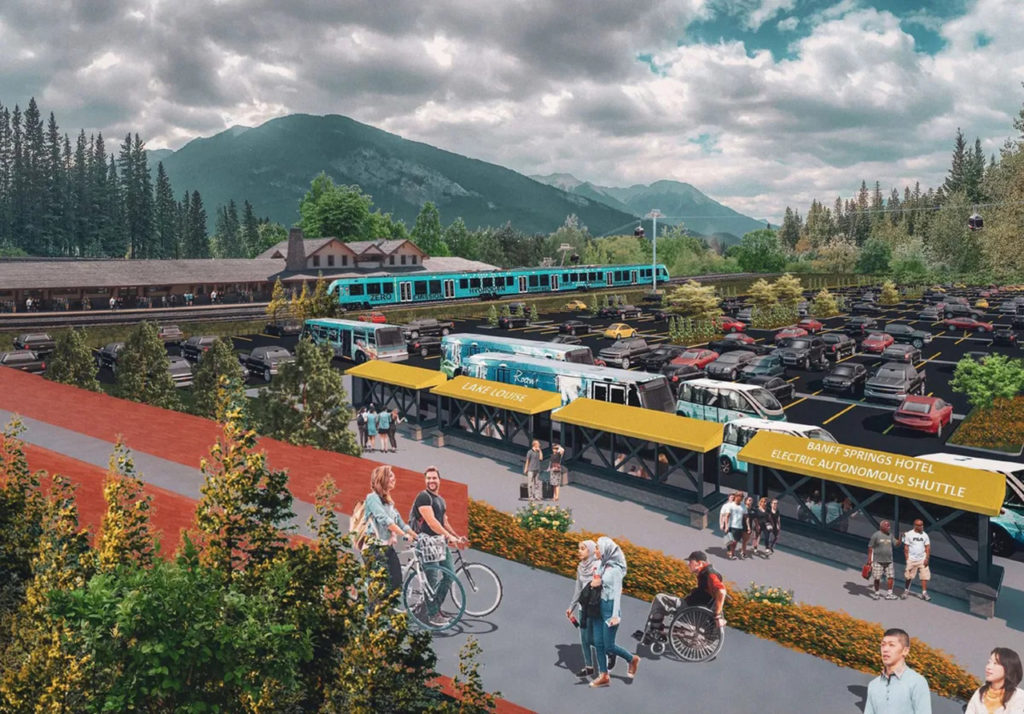
Liricon/Plenary describes CABR as “a distinct stand-alone project but also a key part of an overall transportation vision for Alberta that extends beyond the unique benefits to the Calgary region. CABR, as a brownfield project, is capable of being rapidly advanced by Liricon/Plenary to serve as a foundation upon which to develop a rail hub at the Calgary Airport for future greenfield rail projects, including proposed high-speed rail between Edmonton and Calgary and future expansions of Calgary Transit’s light rail network.”
Liricon/Plenary added it has “conducted significant research on the potential for CABR to use hydrogen-powered rolling stock. This research has entailed multiple meetings and site visits with the major hydrogen rolling stock providers including Alstom, Siemens and Sumitomo. While Liricon/Plenary has not yet selected a rolling stock provider, this alternatives study has increased Liricon/Plenary’s confidence that hydrogen-powered systems are feasible for CABR. In subsequent stages of CABR’s Design Phase, the specific rolling stock provider will be selected.”

Alstom’s Coradia iLint HFC (hydrogen fuel cell) multiple-unit, in revenue service in Europe, is featured on CABR promotional materials. Alstom President and CEO Americas Michael Keroullé has been quoted in CABR promotional materials as saying that “hydrogen rolling stock is ideally suited for application on the Calgary-Banff rail corridor in terms of length of alignment, alignment characteristics and capacity. We firmly believe Alberta possess all the characteristics to become the flag-bearer of hydrogen trains on this side of the Atlantic, and we are very keen to help the province realize what will be recognized as an iconic project throughout the world. Alstom is pleased to offer the benefit of our experience and know-how to bring this project to reality for the benefit of Albertans and indeed to the many global visitors to the province. Alstom is the global pioneer of this technology: Alstom’s Coradia iLint train was unveiled in 2016 and has been in passenger service since 2018 in Lower Saxony, Germany. More than 124,000 miles (200,000 km) [worth of operations] have been completed since the iLint’s entry into service.”
Liricon/Plenary has also “studied potential hydrogen supply alternatives in the Calgary Airport vicinity, in particular, with TC Energy and Suncor. Based on this research, CABR is confident that there will be readily available hydrogen supply for CABR’s hydrogen powered systems for a refueling depot, most likely on Calgary Airport lands.”
In an interview with Railway Age, Liricon Chairman Adam Waterous said the service will be modeled on Switzerland’s Glacier Express, a popular tourist train in the Alps that connects St. Moritz and Davos with Zermatt. As such, CABR, he said, “will be the only regular passenger rail service in North America to a world-class destination.”

Waterous praised Canadian Pacific and its willingness to assist, citing President and CEO Keith Creel and Senior Vice President Strategic Planning and Technology Transformation James Clements has highly supportive. “At the outset, we established a ‘CP First’ mindset,” he said. “We will ensure that freight service is not disrupted. Working with Mott MacDonald, we are developing a construction strategy that relies on using the existing CP corridor to deliver construction personnel and material and minimize the requirement for new construction access roads. Track construction within Banff National Park will be conducted entirely within the CP corridor and will not require the disturbance of Park lands.”
The Calgary to Banff line is 93 miles (150 km) long. James Clements told Railway Age that the CABR line will be built to minimum Transport Canada safety standards, with 20-foot track centers and physical barriers separating CP’s single-track main and the CABR main, also single-track. CP has a non-binding MOU with the project’s developers. Engineering is not expected to be problematic, as the right-of way has ample width to accommodate a dedicated passenger track. “This allows us to protect our freight capacity, both current and future,” he said.
Keith Creel added that “freight capacity and the nation’s commerce is CP’s holy grail to protect.”
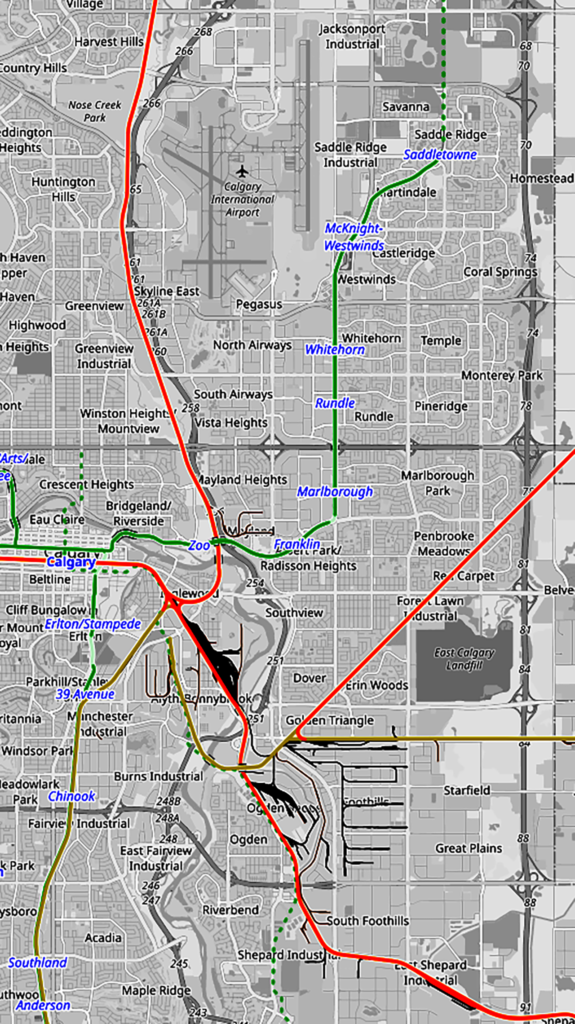
CABR’s “pinch point” will be the 9.3-mile (15 km) line from Calgary Airport to Downtown Calgary, in particular, Calgary Depot, which currently sees only CP freight trains. The right-of-way is narrow. Waterous said in addition to Mott MacDonald, Liricon/Plenary has engaged Stantec as an engineering consultant to design a CABR station in Downtown Calgary that will work within the constraints of CP’s freight operations.

Alberta Transport Minister Prasad Panda, in an interview the Toronto Globe & Mail, said that he admires the intent behind CABR because it could reduce the number of people driving to Banff National Park and help diversify the province’s economy by boosting tourism. But he cautioned that the current plan “underestimates the capital costs and what will be required from the province in terms of an annual financial contribution,” as it “overestimates the potential ridership.” He added that the “construction schedule, which envisions the service running in the mid-2020s, is unrealistic. At this moment, as it’s presented, it’s passing on all the risk to Alberta taxpayers.”
Panda appeared to be echoing the opinion of his boss, Premier Jason Kenney, a Progressive Conservative who theGlobe & Mail said will leave provincial politics in October of this year. “We want a realistic proposal, a feasible proposal,” Panda told the Globe & Mail. “If they can assume those risks, and if they can raise private capital, without penalizing Alberta taxpayers, we’ll reconsider it. Tthere’s still an outstanding question of what the federal contribution to the project will be. So far, it’s only Canada Infrastructure Bank that has said it’s prepared to provide a loan for half the C$1.5 billion capital cost. Proponents want the Alberta government to backstop early project development costs and assume financial risks for the project that will be outside of the province’s control. The province’s annual costs, based on my department’s analysis, would be much more than C$30 million, as would the upfront capital cost estimate of C$1.5 billion.”

“Not surprisingly, the Alberta government wants to reduce the cost to the taxpayer, and our ridership study shows that this is possible,” Liricon Managing Partner Jan Waterous told the Globe & Mail, adding she doesn’t believe the province has responded to all of the proponents’ updated plans. “This is just part of the process of a complex project where ongoing dialogue with the government is paramount.”
Canadian Pacific, which reached Banff a few months after it reached Calgary in 1883, was once the only form of transportation to Banff National Park, established in 1885 as Rocky Mountains Park. CP was instrumental in Banff’s early years, building the Banff Springs Hotel and Chateau Lake Louise, and attracting tourists through extensive advertising. In the early 20th century, roads were built in Banff, at times by war internees from World War I, and through Great Depression-era public works projects. Since the 1960s, park accommodations have been open all year, with annual tourism visits to Banff increasing to more than 5 million by the 1990s. Millions more pass through the park on the Trans-Canada Highway. Except for the Rocky Mountaineer luxury tourist train, one route of which operates on the CP from Banff/Lake Louise to Vancouver, there hasn’t been any passenger rail through Banff since Via Rail Canada took over the CP’s famous Canadian in 1978, rerouting it onto the CN (replacing CN’s Super Continental flagship long-distance train).

About Liricon/Plenary
Liricon is the family holding company of Banff locals Jan and Adam Waterous, who have been facilitating the planning and stakeholder support for the CABR Project for more than five years. Liricon has already entered into a long-term lease of the historic Banff Train Station (built by CP in 1910). Liricon, which also owns the Norquay Ski and Sightseeing Resort, is working with the Town of Banff and Parks Canada to transform the train station into a multi-modal eco-transit hub. Plenary is one of the largest dedicated PPP developers in North America,. Since its founding in Canada in 2005, Plenary has developed and now manages 55 PPP projects in North America, including the Stoney CNG Bus Storage and Transit Facility in Calgary. Plenary is owned by CDPQ (Caisse de dépôt et placement du Québec), a global investment group managing net assets of more than C$390 billion on behalf of more than 40 public pension and insurance plans.



